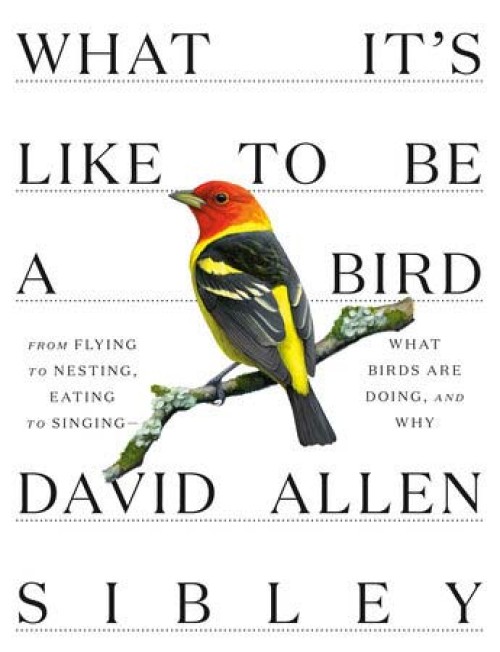by David Allen Sibley, Alfred A. Knopf
New York 2020
Around my home, from April to October, phoebes perch in the open, tails pumping, fixtures in the yard. What robins are to the lawn, phoebes are to the pasture fence and apple trees: reliable, seasonal neighbors. I have three pairs. Their tails mark time, the feathered cadence of the day. For years, I assumed phoebes pumped their tails for balance, maybe in preparation to chase down a moth. David Allen Sibley’s latest book What It’s Like to Be a Bird, a coffee-table reference to the science of birds, set me straight.
Tail-pumping (also called tail-flicking or -wagging) is nonverbal communication directed at a potential predator. The more flicks, the greater threat. “When we get nervous,” writes Sibley, “we fidget. When phoebes get nervous, they wag their tails, and when a predator sees fidgeting or tail wagging, it gets the message that this is a healthy and alert animal and may not be worth chasing. The behavior – fidgeting or twitching under stress – is universal . . .What varies by species is exactly what we do to send the signal.”
Sibley – artist, writer, and author of the preeminent Sibley Guide to Birds – is a force of nature. After a lifetime of watching birds and 15 years working on this book, he concluded, “a bird’s experience is far richer, more complex, and more ‘thoughtful’ than I’d imagined.” What It’s Like to Be a Bird is lavishly illustrated; littered with factoids and analogies, it adds dimension to watching and thinking about birds. But make no mistake, this book is a reference, an ornithological bouillabaisse, not meant to be read straight through.
The second section, “How to use this book,” relays scope and organization, and recommends parameters. It includes the disclaimer “This book is a very selective and incomplete review of bird science, covering topics that I found most intriguing.” That said, David Allen Sibley chairs the department of fascination (for example, one robin eats up to 14 feet of earthworms in a day).
The third section, a 22-page “Introduction,” offers a subject overview from bird diversity to feathers, from coloration to senses, movement and survival to social behavior. Each topic suggests page references, which lead you to more detailed essays. For instance: the subtopic Be Alert, under the larger topic Avoiding Predators, mentions tail-wagging, which sends you to [p. 95 top] the phoebe.
The fourth section, “What It’s Like to Be a Bird,” a portfolio of common North American birds, features 96 species arranged by current taxonomic sequence. On the left-hand side of the page, 87 of the birds are illustrated with full-page, life-size paintings. To the right, opposite each large painting, short essays cover aspects of bird biology. Smaller paintings illustrate each essay. For instance, the phoebe [p. 94] depicts a full-page painting of a black phoebe perched on a lawn chair; to the right [p. 95], three short, illustrated essays discuss tail-pumping, reuse of old nests, and regurgitating a pellet (the indigestible portion of a meal: exoskeletons, fur, feathers, scales, and so forth).
Most of the essays reference related themes elsewhere in the book. Jumping around is a big part of the book’s appeal, which makes for a tedious straight-through read. (You were warned.) Pellets include the parenthetical note [see p. 5 bottom], the snow goose. Here, an essay on grit as a grinding agent in the gizzard (muscular stomach) discusses an alternative to coughing up a pellet. You discover that grit enables a wild turkey to pulverize whole walnuts, surf scoter small clams.
The section entitled “The Birds in This Book,” includes a short paragraph introducing each bird featured in the full-page portraits, adding more information about their habits and relatives. There are cross-references here too.
The two concluding sections, both short, “What to do if . . .” and “Becoming a birder,” cover a variety of topics, such as if a bird hits a window, or if you find a baby bird or a dead bird. A bibliography linked to the short essays directs you to original sources.
Like birds themselves, Sibley’s paintings are full of action and nuance. Three of my favorites: a mockingbird singing at night partially silhouetted by the glow from a window; a blue jay taking off, acorn in bill; and one raven preening the head of another.
Analogies make the book playful as well as useful. A 6-pound heron swallowing a 1-pound fish is equivalent to a 100-pound person swallowing a 17-pound fish . . . whole. Peregrine falcons stoop at speeds of at least 242 miles per hour and make turns that generate 27Gs (force of gravity). We black out at 9Gs.
What It’s Like to Be a Bird is an ornithological treasure hunt. Not just for the obsessed birder, this is an exquisite reference for the curious, novice, and expert alike.


